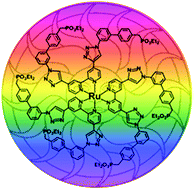Synthesis and characterization of ruthenium and rhenium dyes with phosphonate anchoring groups†
Abstract
Re(L1)–Re(L3), a series of rhenium(I) tricarbonyl chloride complexes with bpy-R2 derivatives L1–L3 (bpy = 2,2′-bipyridine, R represents the substitution at the 4- and 4′-positions), and their corresponding trishomoleptic Ru(L1)3–Ru(L3)3 as well as heteroleptic ruthenium(II) complexes Ru(tbbpy)2(L1) and Ru(tbbpy)2(L2) have been synthesized and characterized. Their applicability as immobilizable metal–organic chromophores in solar and photosynthesis cells is enabled by R, since it includes phosphonic ester groups as precursors for potent phosphonate anchoring groups. Conjugated linkers (phenylene and triazole moieties) serve as distance control between bpy and the anchor. Photophysical and electrochemical studies reveal pronounced effects of the aryl substitution. These effects were further investigated using resonance Raman experiments and supported by theoretical calculations. After hydrolysis the triazole containing Re(L2) was successfully immobilized on NiO, suggesting that its application in photovoltaic cells is feasible. The solid state structures of Re(L0), Re(L0hydrolyzed), Re(L1) and Re(L2) are reported in this paper, enabling the determination of the distances and intermolecular interactions.


 Please wait while we load your content...
Please wait while we load your content...